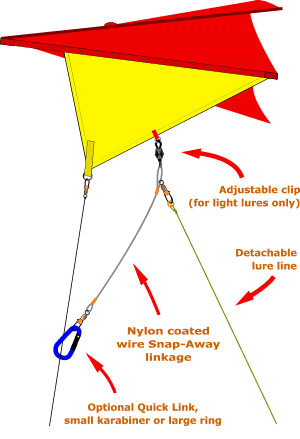
Home - Contents - Catalogs - Falconers section - Knots

The distance from the kite is not absolutely crucial, nor is the length of the lure line, but longer lure lines have been found to be better than short ones through trial-and-error. One falconer tested lure lines attached at different distances from the kite, and determined that about 80 feet was best - closer to the kite and the extra weight interfered with the kite's stability, while lower down caused the the line to sway independently. At 80 feet kite, line and lure all moved together as a unit. The goal is that the kite, line and lure all move together as a unit. Others prefer further down the line, more like 150 feet.
Using a removable attachment, like the Ringboom shown or a Cannon Quick Release, allows complete flexibility as to where the lure is attached. The kite can be left flying while successive heights are used during a single training session. Once the kite is stable, flying in steady wind, the line can be walked down to any desired distance, the lure attached, and the line released.
Instead of using a loop or boom on the flying line ("A" above), the lure line is clipped directly onto a secondary ring on the kite's fin using a SnapAway linkage.
This has several advantages:
The main disadvantages of this method are: 1) if the kite is allowed to do a 360° turn at any time prior to the strike, the lure line will cross over the kite line, and 2) a large bird could attack the lure with enough gusto to swing himself over the kite - such entanglements are avoided with sufficiently long lure lines.
The position for the auxiliary ring was initially determined through trial-and-error at the Welsh Hawking Centre.
Quick Links (steel), split (key) rings, large curtain rings, small carabiners, and plain snap swivels have all been used. Steel quick links, though very secure, weigh four times as much as mini carabiners, which have the advantage of being easily un-clipped with one hand. Most split rings have sharp burrs, so there is always the danger of damaging the flying line, and therefore are not recommended by me. Large curtain rings can't be unclipped from the line. Lure lines can be unclipped from the ring, but then the kite line has to be rewound back through it.
I make complete SnapAway linkages. I can also supply adjustable clips, mini carabiners, and booms separately.
Link to Line and Winders catalog
Needless to say, there are many variations on the basic theme; one falconer uses a "running boom" (for fishing) as a smooth-running down-rig. However, running booms don't pass over knots. Falconers report that any large diameter rings - such as a 2 inch curtain ring - come down reliably, without dragging or snagging. Gerry Plant uses a re-working of an Andy Hollidge idea: a tiny steel ball bearing pulley from a yacht chandlers.
Home - Contents - Catalogs - Falconers section - Knots